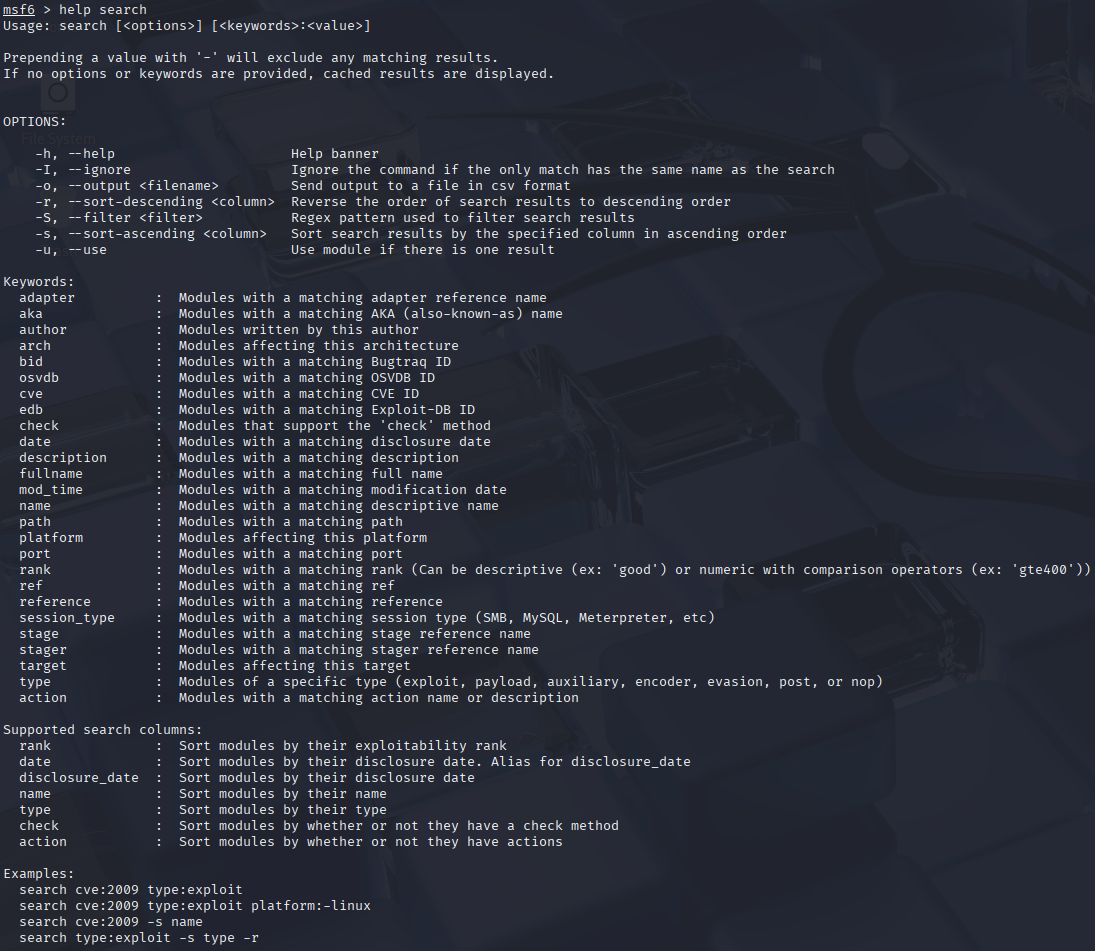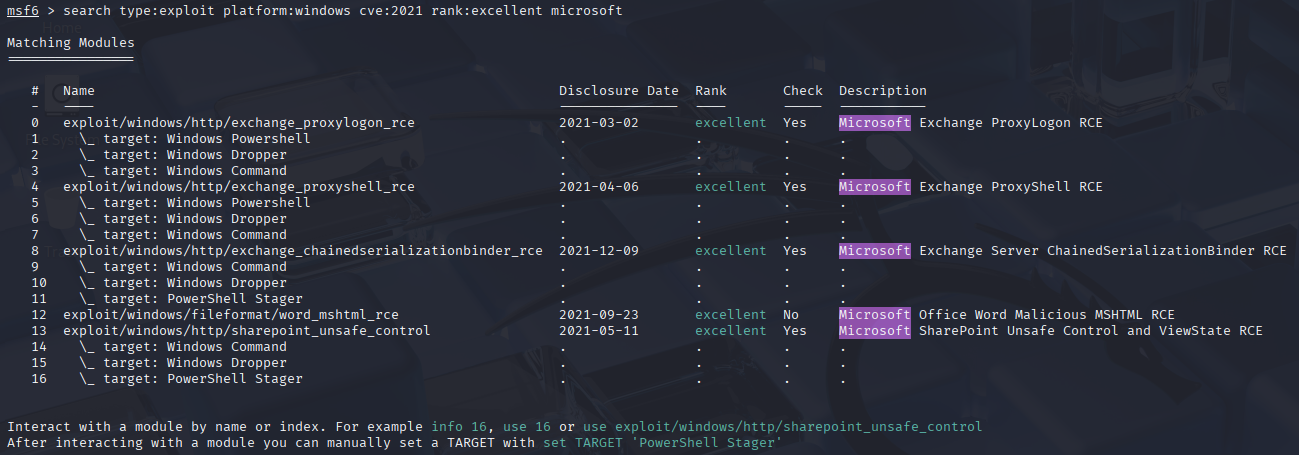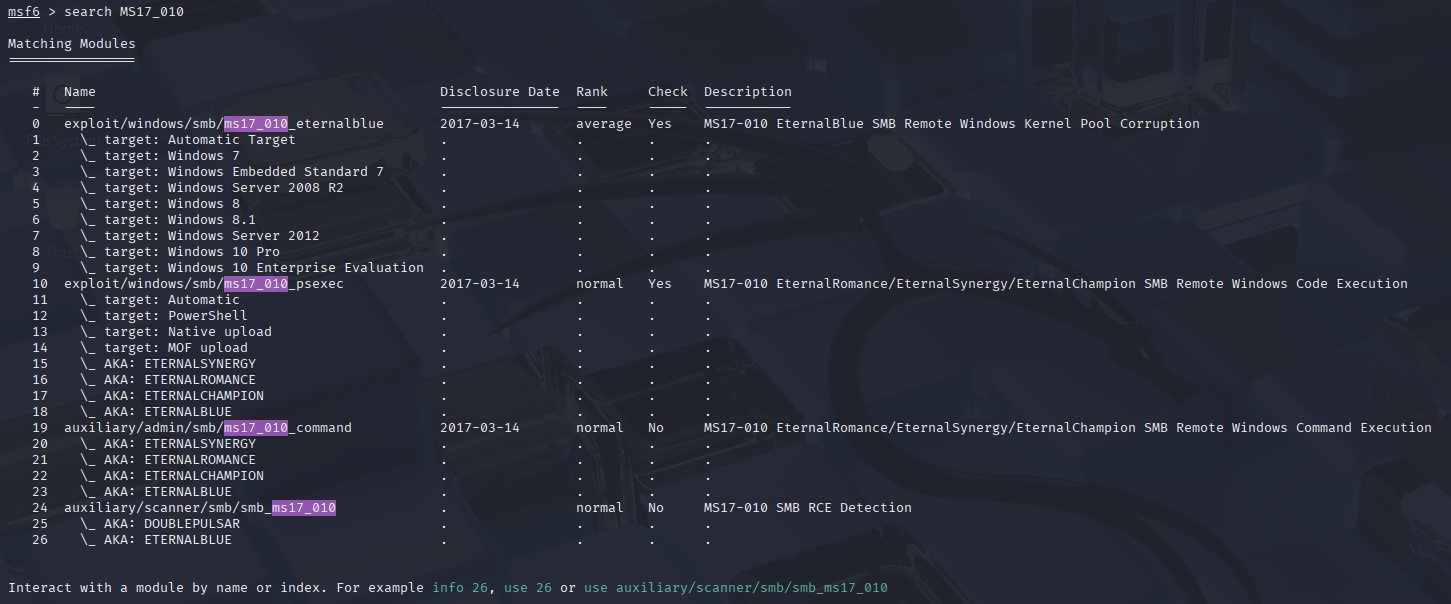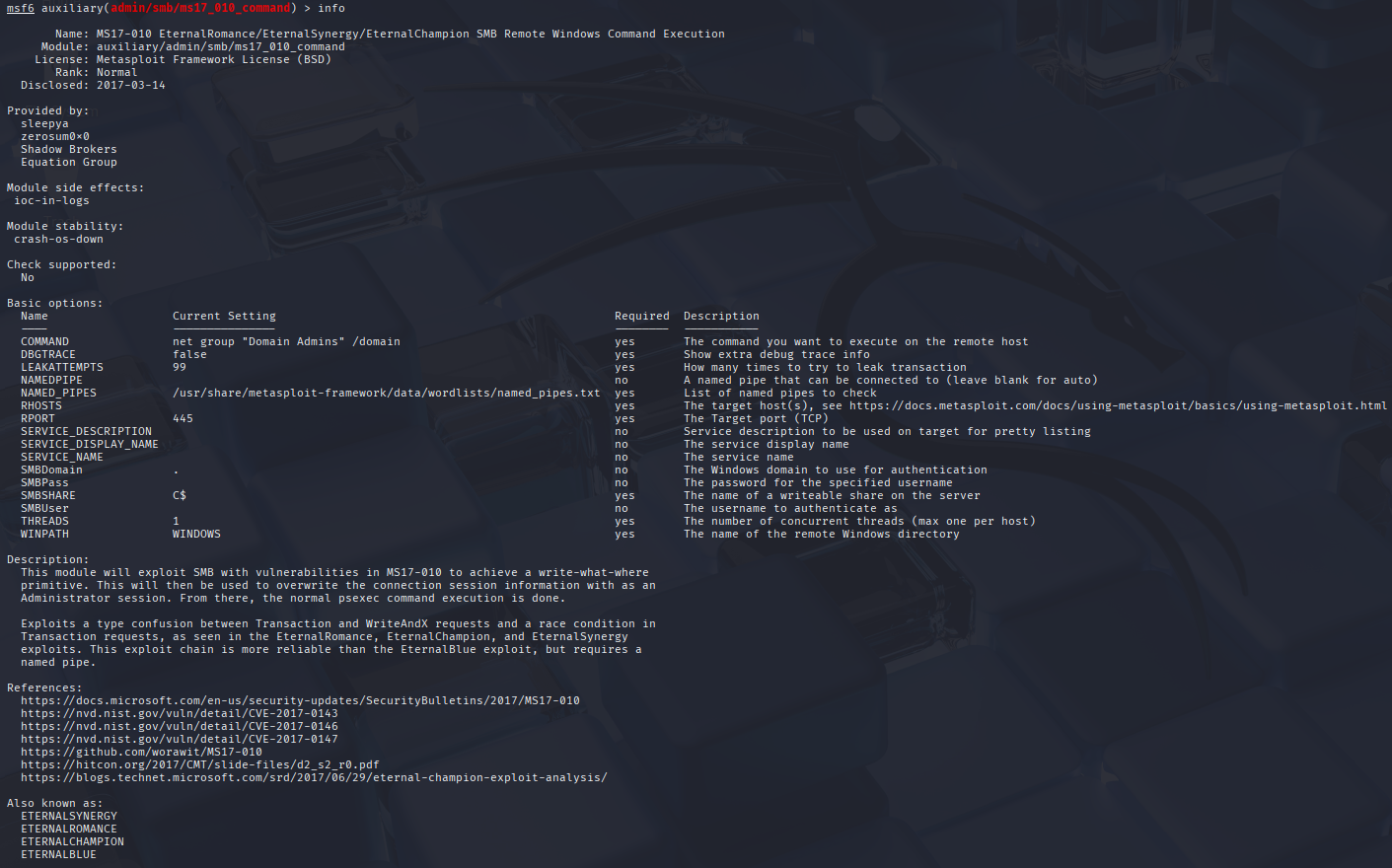Using The Metasploit Framework Contents
Previous Section
What is a Metasploit Module¶
A Metasploit module is a prepared script to meet a specific purpose (i.e. targeting a certain vulnerability) that have been developed and tested in the wild.
The Exploit Category¶
The exploit category of the modules consists of proof-of-concept (POCs) which can be utilised to exploit existing vulnerabilities in an automated manner.
It is important to acknowledge that failure of an exploit does not disprove the existence of the suspected vulnerability however it is only proof that the Metasploit Exploit does not work, not that the vulnerability does not exist.
The problem with false failures of exploit modules can be due to many exploits requiring customisation according to the target hosts to make the exploit work effectively. Therefore automation through the Metasploit Framework should only be considered a support tool and not a substitute for manual skills.
MSFConsole Syntax¶
Example¶
794 exploit/windows/ftp/scriptftp_list
Syntax Explanation¶
<No.> <type>/<os>/<service>/<name>
Syntax of the MSFConsole commands
Index No.¶
The No. tag will be displayed to select the exploit wanted after searches.
Type¶
In Metasploit, the Type tag specifies the purpose of a module's code. Unlike exploit modules, which are directly executable, types are designed to define the structure and behaviour of modules, enhancing modularity and organization. They work alongside interactive modules to create a cohesive framework.
| Type | Description |
|---|---|
| Auxiliary | Scanning, Fuzzing, Sniffing, Admin Capabilities. Offer extra assistance & functionality. |
| Encoders | Ensure that payloads are intact to their destination. |
| Exploits | Defined as modules that exploit a vulnerability that will allow for the payload delivery. |
| NOPs | (No Operation Code) Keep the payload sizes consistent across exploit attempts. |
| Payloads | Code runs remotely and calls back to the attacker machine to establish a connection (or shell). |
| Plugins | Additional scripts can be integrated within an assessment with the msfconsole and coexist. |
| Post | Wide array of modules to gather information, pivot deeper, etc. |
When selecting a module to use for payload delivery the use of
use <no.>command can only be used with modules that can be used as initiators (i.e. Auxiliary, Exploits, and Post).
OS¶
The OS tag specifies the operating system and architecture the module was created for as different operating systems require different codebases to interact and deliver the desired results.
Service¶
The Service tag in Metasploit identifies the vulnerable service (e.g., FTP, SMB, HTTP) running on a target machine that a module targets, or, in the case of auxiliary or post-exploitation modules, it may describe a broader activity like gather for collecting credentials or other data, enabling users to select the appropriate module for precise and efficient operations across various exploit scenarios.
Name¶
The Name tag explains the actual action that can be performed using the module.
Searching For Modules¶
Metasploit also offers a search function for existing modules with the help of this function, modules can be very quickly be searched through using specific tags to find a suitable one for the target.
MSFConsole Search Function¶

MSF - Searching for EternalRomance Exploit¶
EternalRomance is an old windows exploit which targets SMBv1 server in Windows, and allows the intruder to execute arbitrary code remotely. This vulnerability is known as RCE (Remote Code Execution).
msf6 > search eternalromance

MSF - Specific Search¶
msf6 > search type:exploit platform:windows cve:2021 rank:excellent microsoft

| Search Parameter | Description |
|---|---|
cve:<year> | Searches for modules associated with a specific CVE (Common Vulnerabilities and Exposures) identifier, filtered by the year the vulnerability was disclosed. For example, search cve:2023 will return modules linked to CVEs from 2023. |
platform:<os> | Filters modules based on the target operating system or platform they affect, such as windows, linux, osx, android, or multi. For example, search platform:windowsreturns modules targeting Windows systems. |
rank:<rank> | Filters modules by their reliability or success rate, as defined by Metasploit's ranking system. Ranks include low, normal, good, great, excellent, or numeric values (e.g., gte400 for ranks greater than or equal to 400). For example, search rank:excellent returns high-reliability exploits. |
Search Name <pattern> | Searches for modules whose descriptive name or path matches the specified pattern. For example, search name:smb finds modules related to SMB (Server Message Block) protocols. Patterns can be partial matches or keywords. |
Hypothetical Target Running SMB¶
Module Selection¶
To begin assume a target exists running a version of SMB vulnerability to EternalRomance (MS17_010) exploits.
Step 1) Scan for Services¶
TheMalevolent1@htb[/htb]$ nmap -sV 10.10.10.40
Starting Nmap 7.80 ( https://nmap.org ) at 2020-08-13 21:38 UTC
Stats: 0:00:50 elapsed; 0 hosts completed (1 up), 1 undergoing Service Scan
Nmap scan report for 10.10.10.40
Host is up (0.051s latency).
Not shown: 991 closed ports
PORT STATE SERVICE VERSION
135/tcp open msrpc Microsoft Windows RPC
139/tcp open netbios-ssn Microsoft Windows netbios-ssn
445/tcp open microsoft-ds Microsoft Windows 7 - 10 microsoft-ds (workgroup: WORKGROUP)
49152/tcp open msrpc Microsoft Windows RPC
49153/tcp open msrpc Microsoft Windows RPC
49154/tcp open msrpc Microsoft Windows RPC
49155/tcp open msrpc Microsoft Windows RPC
49156/tcp open msrpc Microsoft Windows RPC
49157/tcp open msrpc Microsoft Windows RPC
Service Info: Host: HARIS-PC; OS: Windows; CPE: cpe:/o:microsoft:windows
Service detection performed. Please report any incorrect results at https://nmap.org/submit/ .
Nmap done: 1 IP address (1 host up) scanned in 60.87 seconds
NMap of hypothetical target
Vulnerability for
M17_010--> 445/tcp open microsoft-ds Microsoft Windows 7 - 10 microsoft-ds (workgroup: WORKGROUP)
Step 2) MSF - Search for MS17_010¶

The NMap scan shows that the port 445/TCP is open which is the SMB (Server Message Block) protocol, this version Microsft Windows 7 - 10 is vulnerable to EternalRomance. Next is selecting the appropriate module index no. 16 to test if the target is vulnerable. use and index number allows module selection.
Step 3) Using Modules¶
In most cases multiple IP addresses need to be scanned or attacked, therefore it is required that this functionality allows us in Metasploit to adapt the tool to the situation effectively, setting targets and fine-tuning them. To view which options are needed to be set before the exploit can be utilised, the show options command; which includes everything required to set before the exploitation occur, which should have a Yes under its Required column.
use 19 from the search image.

Using the info command displays the module's information.

Step 4) MSF - Target Specification¶
set RHOSTS or RHOST (Remote Hosts) to the target's IP address set RHOSTS 10.10.10.40
use the setg command to change (global variables) for Permanent Target Specification setg RHOSTS 10.10.10.40